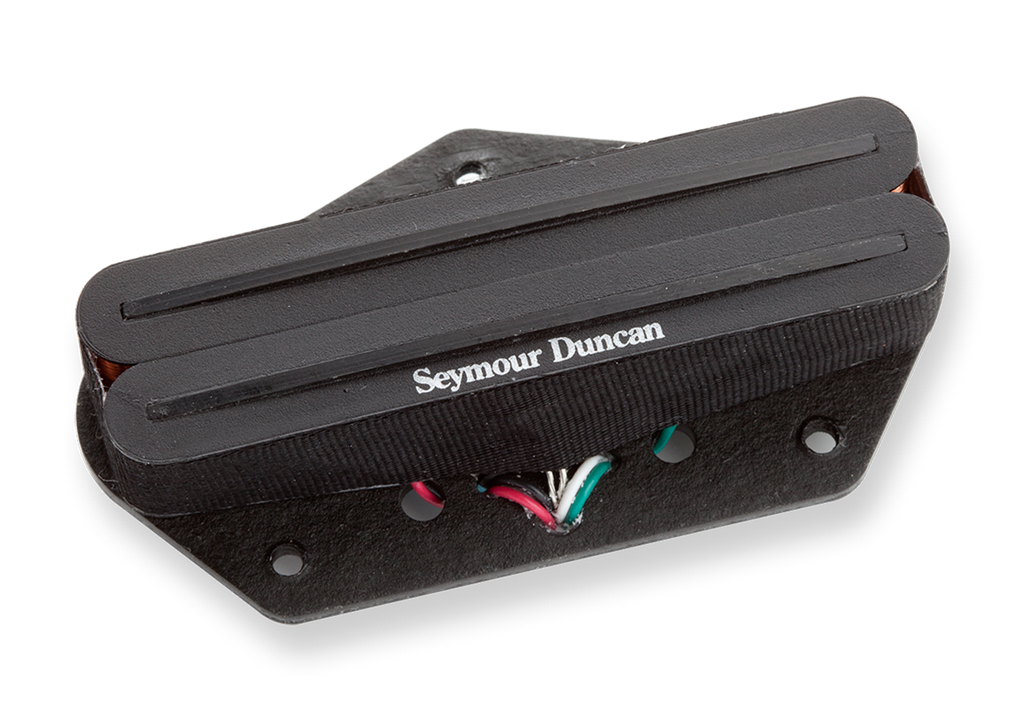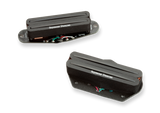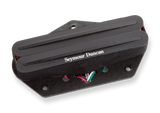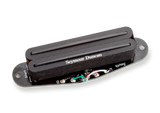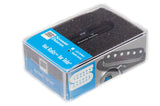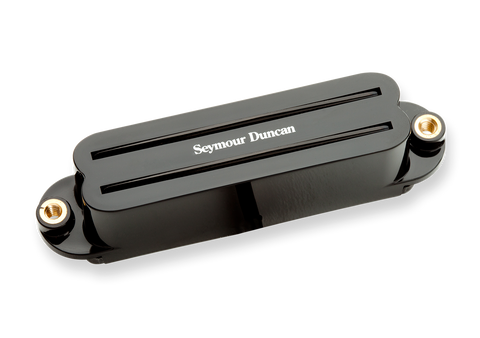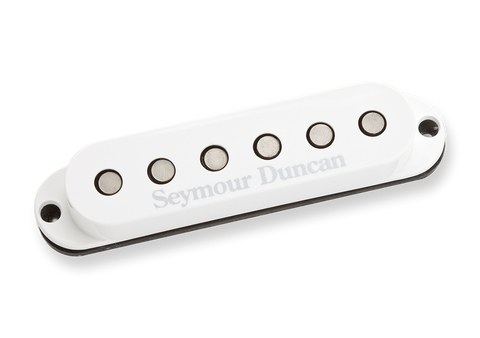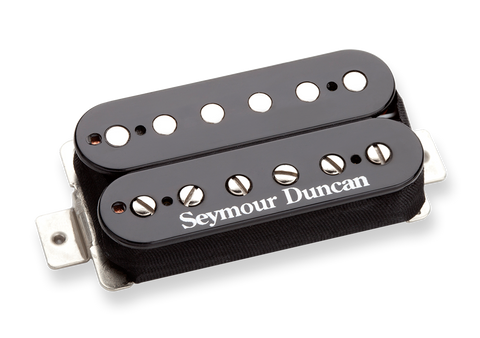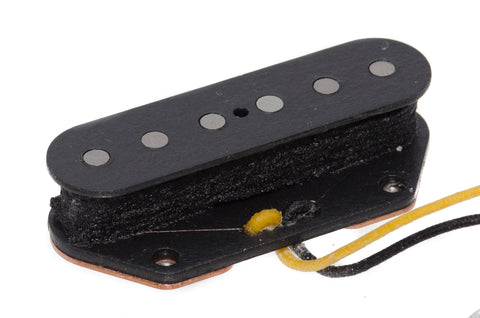From the manufacturer:
"application
High output single-coil-size "rails" humbucker. Great for classic rock, garage, punk, heavy rock, thrash, classic metal and nu-metal.
description
Delivers a fat, full sound with incredible output. The powerful ceramic magnet, two steel blades and over-wound coils all combine to provide a heavy, raw, distorted tone with incredible sustain. Compared to the Little '59, Hot Rails has more output and a chunkier mid-range. Comes in black only with four-conductor cable.
complete setup
Now available in a new neck version as well as a bridge version. Matches well with a hot distortion pedal like the SFX-04 Twin Tube Mayhem or the SFX-08 Power Grid
guitars
For all well-balanced instruments. Works equally well with maple and rosewood fingerboards.
players
Troy Van Leeuwen / Queens of the Stone Age, Mike Stern, John 5 / Marilyn Manson & Rob Halford, Joe Trohman / Fall Out Boy"
Best videos/sound clips:
These Tele Hot Rails pickups are super high-output and Steve Booke puts them to good use in this video almost immediately. At 0:08, we hear the STHR-1b in all its glory, driving a high gain amplifier and playing a heavy riff. The lead comes in at 0:14, played using the STHR-1n. You can really hear the articulation and attack with this pickup. We get to hear the pickups in the middle position using a clean tone at 0:41, and we hear the clarity of the midrange of these pickups. At 0:54, the pickup selector stays in the middle, but the high gain is turned on. We hear that these pickups have not only an increased output, but also increased sustain. The riff at 1:21 is played with a moderate amount of gain, using the STHR-1b only, and at 1:34 to the end, we hear the powerful lead sound of the STHR-1b. Steve does a good job demonstrating the Hot Rails pickups in different tonal contexts, and he executes his passages nicely.
This video features the STHR-1b only and it is BOOMERGUITAR1 playing his 1989 Fender American Standard Telecaster through Native Instruments' Guitar Rig 5. You can really hear how well the pickup sustains, due to its increased output. Good Stuff @ 1:30.
This video by Randy Fender features the STHR-1b used in conjunction with his Fender American Standard Telecaster's stock neck pickup, with really nice results. Really tasty playing with a moderately dirty sound from the beginning, giving way to a higher gain, singing lead that takes full advantage of the STHR-1b's sustain increase. Watch for the shred festival at 1:44!
Wow. This guy is like Joe Satriani Disguised as a British Cab Driver. He's using his Fender Standard Telecaster with the STHR-1b and STHR-1n through a Line 6 SpiderJam. He's getting a really amazing high gain sound from this Telecaster thanks to the STHR-1b and STHR-1n. Upon first listen, you might think he's playing an Ibanez or Jackson, or another guitar associated with super saturated guitar sounds. The STHR-1b and STHR-1n turn this simple Tele into a fire-breather, though. There's a really nice build at 1:22, really great 12/8 tripets. At 2:20 he treats us to some nice 6ths. He even makes some faces at 2:43 before melting our faces at 2:47. Just when you think he has emptied his bag of tricks, he puts down the pick and plays with just his fingers from 3:26 to the end.
This video features the STHR-1b and STHR-1n installed in a custom made Tele style guitar being played through a Vox Night Train head. Skip ahead to 1:37 to avoid the intro. He starts by plying the STHR-1b for a bit, with a moderate gain sound, and you can really hear the bite and increased sustain the STHR-1b gives a Tele-style guitar. At 2:48, he switches to the STHR-1n, and we hear it in a funky rhythm style application. Sounds VERY humbucker-y to my ear here not what I expect in a Tele neck pickup at all, which is nice. Also in this section, he turns volume down and plays some jazz chords, so we can hear the meatiness of the STHR-1n. It cleans up surprisingly well for a high gain pickup when the volume knob is rolled down. He increases the amp's gain at 3:45, and turns the guitar's volume control all the way up again, and we hear the overdrive and the thick harmonic definition of the STHR-1b playing power chord rhythms. Single notes are featured at 4:30, before he turns the volume control down again at 5:02 so we can hear the way the STHR-1b affects the high gain amp sound. He switches to the middle position at 5:26, and turns the volume all the way up. This sound really reminds me more of a Les Paul in the middle postion than a Tele in the middle position. We hear the massive amount of sustain the STHR-1b and STHR-1n have at 5:33. At 5:36, we are in STHR-1n land again, first some single notes with moderate gain, then with higher gain at 5:53. He does a very good job of letting us hear these pickups with different gain settings.
This video is another that only features the STHR-1b. From 0:02, we hear an extended clean rhythm section with a little chorus. Notice the frequency bump in the high mids. At 1:13, he gives us a little taste of some soloing, sounding to me like it's a distortion pedal straight into his interface, which is a good way to hear the way the STHR-1b responds to distortion with clarity. He steps on the Wah pedal at 2:24, and adds some delay at 2:47. With the delay and Wah pedal off, we hear just chorused distortion at 3:37. And at 4:17, he adds an octave pedal. I think he's trying to use every pedal on his pedalboard in one solo! We hear the STHR-1b all by itself and crystal clear again at 4:52, concluding our tour through the tones one can achieve going direct into one's interface through one's pedalboard. He then moves on to the neck pickup for the rest of the video.
Here we have a video that features only the STHR-1b, this time in a Seymour Duncan made Tele-style guitar. He plays the main riff of this tune at 0:07, and we hear the brightness and loudness of the STHR-1b. A more chordal section follows, at 0:30. At 1:16, we hear the epic chorus, played with predominantly power chords, and at 1:35, we hear a double stop section toward the middle of the neck. Listen for the broad harmonic range of the STHR-1b, but notice it's high mid emphasis. There is a lengthier double stop bridge section, played mostly in the open position this time, at 1:47. At 2:09, there is a single note guitar solo. When I close my eyes, I forget that this is being played on a Tele-style guitar! The STHR-1b has so much more output and a much thicker frequency responce than a standard Tele bridge pickup. Another chorus, another double stop section, and another round of the intro riff and we're out.
In thise video, we have something really interesting: this guy plays through pieces of all kinds of classic rock songs, first with the stock pickups in his Fender Squier Telecaster, then through the same pieces of the same songs with the Squier's pickups changed to the STHR-1b and STHR-1n. At first, we hear the guitar with a basic clean sound from his Fender Blues Junior amplifier, from 0:00 to about 1:47. What's realy cool is he's edited together the clips so they bounce back and forth between the stock pickups and the STHR-1b and STHR-1n's without skipping anything, so we can hear a true A/B comparison. At 1:47, he turns on the Axis Fuzz by Roger Mayer and you can definitely hear how the guitar's voice opens up and gets louder with much more thickness and depth when the STHR-1b and STHR-1n are in the guitar. At 3:43, we get to hear how the middle positions compare. Again, we get a bit more punch and brighness in the high mids with the STHR-1b and STHR-1n. At 4:00, we get another distortion sound, and overdrive this time, the Fulltone OCD. This continues until about 5:29, when we hear each set of pickups through an Electro-Harmonix Metal Muff. I think this is where these pickups are at their best: super saturated high gain, with thick velvety harmonics. There is a little weirdness where there isnt't a TRUE A/B comparison happening, from 5:29 to 6:26, where the clips alternate from the STHR-1b to the stock pickups in the middle position, but it's a good comparison from 6:26 on. Really nice video. Excellent way to compare stock pickups vs. the STHR-1b and STHR-1n in an actual playing context.

